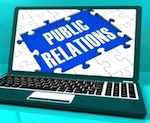The First 14 Immutable Rules for Successful Healthcare Public Relations
A fundamental guide for hospital, provider and healthcare organization news releases and media relations.
 The process of "getting ink" —when your news release or story idea finally appears in the media—has always been a challenge. Often it's more of an art than a science, enlivened by a generous splash of good luck.
The process of "getting ink" —when your news release or story idea finally appears in the media—has always been a challenge. Often it's more of an art than a science, enlivened by a generous splash of good luck.
(For simplicity in this article, references to "publications" generally include all media outlets...print, broadcast or online.)
Anyone in healthcare public relations and marketing—from providers, to hospitals, to medical organizations and manufacturers—knows that capturing "free publicity" is increasingly difficult these days. Competition for space is fierce, and the news industry and media itself is changing rapidly.
Typical of this media metamorphosis, there are fewer newspapers and the surviving media outlets have smaller staffs and resources. Internet news platforms, on the other hand—with websites, blogs and even social media—have exploded. The "traditional" publications are scrambling to find a digital format that retains an audience and a revenue stream.
Some rules haven't changed.
As a fundamental guide for hospital, provider and healthcare organization news releases and media relations, we've listed the top, immutable rules for getting your PR idea through the media maze and into print. We recognize that this is only the short list, and we welcome your comments and nominations for additional tips and techniques for success. Our "rules" are presented in random order:
- Know the publication and their audience (readers/viewers). There's a world of difference between the New Castle (PA) Shopkeeper Monthly, the Baltimore (MD) Business Journal, Sports Illustrated and Country Living. Each has its own style, tone of voice and perspective on the world. Read the publication to understand. And know their special requirements and deadlines.Recently we published this post about THE essential key to a successful healthcare PR news release. The advice of a senior editor: "The first PR person who sends me a press release that starts with the benefit to my readers as to why this announcement is important will really get my attention, if not gratitude."
- Know your own audience. Your message is for a specific target audience. Understand all you can about the audience you need to reach. Picture a representative individual that fits the description and write to this one person.
- Target the editor/reporter (gatekeeper/decision-maker). Reporters have assignment areas, personal interests, deadlines, submittal preferences and a dozen other matter factors about what and how they present to their readers. Read articles that the reporter has written and create your information to be useful and appropriate to them. The reporter works for his/her readers. Personalize your pitch or release to the needs of the gatekeeper with a message that helps them do their job.
- Bust through the clutter. A message or pitch with impact—one that is unusual, unique and/or notably interesting—can stand out in the crowd of a million other releases, grab the reporter's attention and (maybe) get published.
- Be timely. By definition, if there's nothing "new," it's history. A feature item may be less urgent, but can still have a timely angle.
- Think local first. People relate to news that's nearby and part of the world as they experience it daily. Be clear about how the information in a news release or story idea is grounded in, and meaningful to, people or businesses in the immediate area.
- Watch your language. Editor's axiom: "No one will ever complain because you have made something too easy to understand." Be clear, precise, honest, straight forward and accurate in what you say. Avoid jargon, buzz words, cliches and super-technical talk even with sophisticated audiences. (Ditto for anything vague, convoluted and/or confusing. Reporters will not invest a nanosecond looking for a decoder ring.)
- Have command of your own material. Be prepared to field questions from a reporter who is considering your pitch or story. Know the facts and don't speculate. Understand that everything is on the record, and you are likely to be quoted. Provide immediate access to an expert, authority or qualified spokesperson if possible.
- Appeal to the heart and the head. Look for a compelling, emotional connection that's meaningful and touches the individual reader. How does your information help someone? What is the human interest value?
- A little self-promotion may be too much. Public relations efforts inform, persuade and influence, but heavy-handed self-promotion is a turn-off in the news room. Likewise with puffery and exaggeration.
- Hold your support materials at the ready. Generally, reporters and editors want a brief, to-the-point pitch or submittal to start. Let them know that backup data, reference materials, fact sheets, photos, videos or other collateral is available. There are exceptions to this, so it pays to know the preferences of the editor, reporter or publication. Sometimes secondary information-photos, video clips, and the like-can help inspire interest.
- Proofread what you write (before you send). An editor will not read past the first typographical error, no matter how minor. Better yet, have someone else proofread what you intend to send to an editor.
- If your first paragraph does not generate interest, all other words will not be read.
- Reporters appreciate a personalized "Thank You" for a job well done.
This is an open-ended list, so please send us your nominations for additional tips and healthcare PR rules for success. You'll find additional articles in this series begin here with, Healthcare Publicity: The First Three Steps to Getting Free Press Coverage, from our library of free reference articles.
We're here to help. Marketing, advertising and public relations for professionals and health care organizations can grow your reputation, build your image and enhance your brand.








